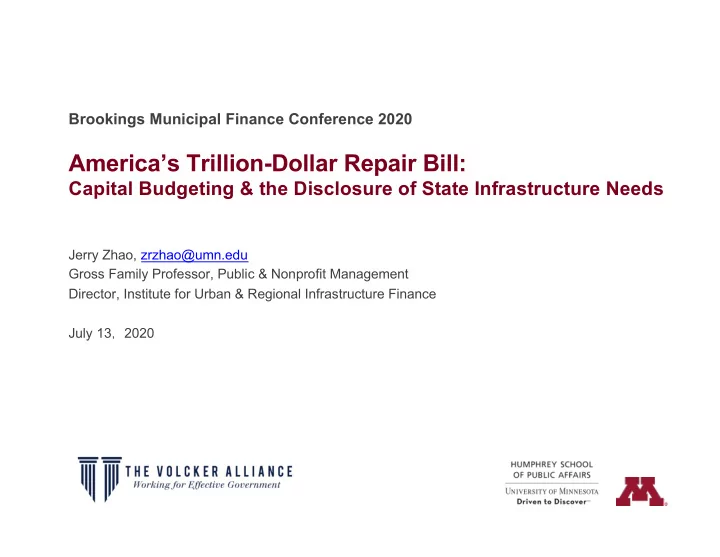

Brookings Municipal Finance Conference 2020 America’s Trillion-Dollar Repair Bill: Capital Budgeting & the Disclosure of State Infrastructure Needs Jerry Zhao, zrzhao@umn.edu Gross Family Professor, Public & Nonprofit Management Director, Institute for Urban & Regional Infrastructure Finance July 13 , 2020
Outline • Background of the research • Literature review and methods • Findings about state capital budgeting practices – State capital budgeting processes – State capital budgeting documentation – State capital needs disclosure • Call to action: – Ten steps toward better disclosure • Conclusion 2
Key questions about infrastructure investment • Revenues: infrastructure funding & financing – Funding: general revenues, special revenues – Financing: debt; public-private partnerships • Expenditures: capital budgeting and infrastructure outlays – Capital budgeting system – The structure of capital outlays – Allocation of infrastructure spending • Outcome: the impact of infrastructure investment – Economic impact – Equity impacts – Democratic values 3
4
Literature on state capital budgeting • Capital budgeting system – “Central state capital budgeting” (Hillhouse & Howard 1963) – A 50-states survey of capital budgeting (Lawrence & Peroff 1988) – Economic decline and capital budgeting (Ermasova 2013) • Processes and documentation – Good practices of capital budget processes (NASBO series) – Capital budgeting documents (GFOA 2016, 2018) • State infrastructure needs – A Report on America’s Public Works (NCPWI 1988) – Infrastructure Report Card (ASCE 2017) – The quality of management (Barrett & Greene 2008) 5
6
A document analysis of state capital budgeting • Capital budgeting processes – Budget instructions – Governmental websites • Capital budgeting documentation – Adopted bills containing capital improvement projects – Capital Improvement Plans (CIPs) • Disclosure of infrastructure needs – Infrastructure needs reports – Deferred maintenance • Best-practices recommendations – Processes, documentation, and disclosure 7
Findings: State capital budgeting processes • The level of separation in the budget cycle – Most states treat the two budgets simultaneously – Only MN and OH have totally separate CB processes • Office or division for capital budget preparation – Different levels of separation in about 20 states – Dedicated committee for CB preparation in 11 states – Dedicated committee for CB adoption in 15 states 8
Findings: State capital budgeting processes 9
Findings: State capital budgeting processes 10
11
Findings: State capital budgeting documentation • Capital budget document – As an individual document in 30 states – As an individual (sub)section in 13 states – As individual line items in 7 states • Capital Improvement Plans – Available in 36 states + DC – About half of them use centralized CIP – Others with only individual agency plans – Some more details about CIP coverage 12
TABLE 8: Where Centralized Capital Improvement Plans Are Used NO CAPITAL IMPROVEMENT CENTRALIZED CAPITAL PLAN CONSOLIDATING STATE IMPROVEMENT PLAN INDIVIDUAL AGENCY PLANS NEITHER Alabama Alaska Arizona Arkansas California Colorado Connecticut Delaware District of Columbia Florida Georgia Hawaii Idaho Illinois Indiana Iowa Kansas Kentucky Louisiana Maine Maryland Massachusetts Michigan Minnesota Mississippi Missouri 13 Montana Nebraska Nevada New Hampshire
14
Findings: State infrastructure needs disclosure • To distinguish the key concepts • Reports on infrastructure needs – Only in six states and DC • The disclosure on deferred maintenance – Inconsistent, incomprehensive, and unsystematic 15
Findings: State infrastructure needs disclosure 16
CA’s deferred maintenance is about 44% of its annual budget. Assuming the share is similar across all states, the total state maintenance gap is about $870 billion. Combining with a federal maintenance gap of $170 billion, the total is well above $1 trillion. 17
Call to action: Steps toward better disclosure 18
Conclusion • Capital budgeting system matters • Findings about current practices: – State capital budgeting processes – State capital budgeting documentation – State capital needs disclosure • Recommendations – More separation in processes and offices – Standardizing capital budget documentation – Improving disclosure on infrastructure needs and gaps 19
For future discussion and comments Prof. Jerry Zhirong Zhao Humphrey School of Public Affairs University of Minnesota zrzhao@umn.edu 20
Recommend
More recommend